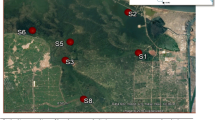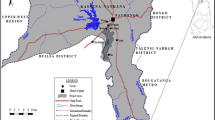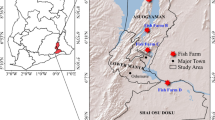Abstract
Water, sediment, red swamp crayfish (Procambarus clarkii) and black bass (Micropterus salmoides) from Lake Naivasha were analyzed for selected organochlorine and organophosphorus pesticide residues. The mean p,p'-DDT, o,p'-DDT and p,p'-DDE residue levels recorded in black bass (28.3 (± 30.0), 34.2 (±54.0) and 16.1 (±16.1) μg kg−1, respectively) and crayfish (4.6 (±5.1), 3.2 (±2.8), and 1.4 (±1.1) μg kg−1, respectively), were higher than previously recorded. This indicated recent usage of technical DDT in the lake's catchment. Levels of p,p'-DDT, higher than those of p,p'-DDE further emphasized this. Mean lindane, dieldrin, β-endosulfan and aldrin concentrations in black bass were 100.5, 34.6, 21.6 and 16.7 μg kg−1, respectively. The same residues were detected at lower concentrations in crayfish at 2.0, 2.0, 2.0 and 1.9 μg kg−1, respectively. The higher fat content (3.7 ± 2.7% SD) in black bass (compared to 0.6 ± 0.3% in crayfish) accounted for the significantly higher residue concentrations in black bass. Organophosphate pesticides were the most commonly used pesticides in the lake's catchment, but none was detected in any of the samples. The results indicate that there is need for further work to identify sources and fate of pesticide contaminants, as well as to improve monitoring of pesticide use throughout the catchment.
Similar content being viewed by others
References
Frank, L. G., R. M. Jackson, J. E. Cooper & M. C. French, 1977. A survey of chlorinated hydrocarbon residues in Kenyan birds of prey. E. Afr. Wildl. J. 15. 295–304.
Greichus, Y. A., A. Greichus, B. D. Aman & J. Hopcraft, 1978. Insecticides, polychlorinated biphenyls and metals in African lake ecosystems III, Lake Nakuru, Kenya. Bull. Environ. Contam. Toxicol. 19. 455.
Kanja, L., J. U. Skaare, I. Nafstad, C. K. Maitai & P. Lükken, 1986. Organochlorine pesticides in human milk from different areas of Kenya 1983–1985. J. Toxicol. Environ. Health 19. 449–464.
Koeman, J. H., J. H. Pennings, J. J. M. De Goeij, P. S. Tjioe, P.M. Olindo & J. Hopcraft, 1972. A preliminary survey of the possible contamination of Lake Nakuru in Kenya with some metals and chlorinated hydrocarbons. J. Appl. Ecol. 9. 411.
Lalah, J. O. & S. O. Wandiga, 1996. The persistence and fate of malathion residues in stored beans (Phaseolus vulgaris) and maize (Zea mays). Pestic. Sci. 46. 215–220.
Lincer, J. L., D. Zalkind, L. H. Brown, & J. Hopcraft, 1981. Organochlorine residues in Kenya's Rift Valley lakes. J. Appl. Ecol. 9. 411.
Mitema, E. S. & F. K. Gitau, 1990. Organochlorine residues in fish from Lake Victoria in Kenya. Afr. J. Ecol. 28. 234.
Mugachia, J. C., L. Kanja & F. Gitau, 1992a. Organochlorine pesticide residues in fish from Lake Naivasha and Tana River, Kenya. Bull. Environ. Contam. Toxicol. 49. 207–210.
Mugachia, J. C., L. Kanja & T. E. Maitho, 1992b. Organochlorine pesticide residues in estuarine fish from the Athi River, Kenya. Bull. Environ. Contam. Toxicol. 49. 199–206.
Mugambi, J. M., L. Kanja, T. E. Maitho, J. U. Skaare & P. Lokken, 1989. Organochlorine pesticide residues in domestic fowl (Gallus domesticus) eggs from central Kenya. J. Sci. Food. Agric. 48. 165–176.
Munga, D., 1990. DDT and endosulfan residues in four tropical fish species. In: Khan, M. R. & H. J. Gijzen (eds), Environmental Pollution and its Management in Eastern Africa. Proceedings of a Symposium organised by the Faculty of Science, University of Dar es Salaam, 11–14th Sept. 1989.
Natural Resources Institute, 1991. NRI Pesticide Management Section. Training Manual for Pesticide Residue Analysis Vol. 2. Natural Resources Institute, U.K.
Pastor, D. J. Boix, V. Fernandez, & J. Albaiges, 1996. Bioaccumulation of organochlorinated contaminants in three estuarine fish species (Mullus barbatus, Mugil cephalus and Decentrarcus labrax). Mar. Pollut. Bull. 32. 257–262.
PCPB, 1998. List of Pest Control Products Provisionally Registered by the Pest Control Products Board for use in Kenya. (Revised June, 1998). PCPB, Nairobi.
Tanabe, S., A. N. Subramanian, A. Ramesh, P. L. Kumaran, N. Miyazaki & R. Tatsukawa, 1993. Persistent organochlorine residues in dolphins from the Bay of Benghal, south India. Mar. Pollut. Bull. 26. 311–316.
Wandiga, S. O., 1996. Organochlorine pesticides: curse or blessing in tropical agriculture? In: Wandiga, S. O. & N. L. Abuodha (eds), Environment and Development in Kenya. Research Papers Presented at Academy Public Lecture Series. Kenya National Academy of Sciences, Nairobi.
UNEP, 1993. United Nations Environment Programme Environmental Data Report 1993–94. Blackwell Publishers, Oxford.
Author information
Authors and Affiliations
Rights and permissions
About this article
Cite this article
Gitahi, S.M., Harper, D.M., Muchiri, S.M. et al. Organochlorine and organophosphorus pesticide concentrations in water, sediment, and selected organisms in Lake Naivasha (Kenya). Hydrobiologia 488, 123–128 (2002). https://doi.org/10.1023/A:1023386732731
Issue Date:
DOI: https://doi.org/10.1023/A:1023386732731




